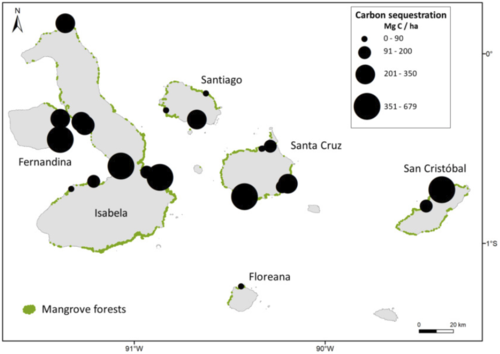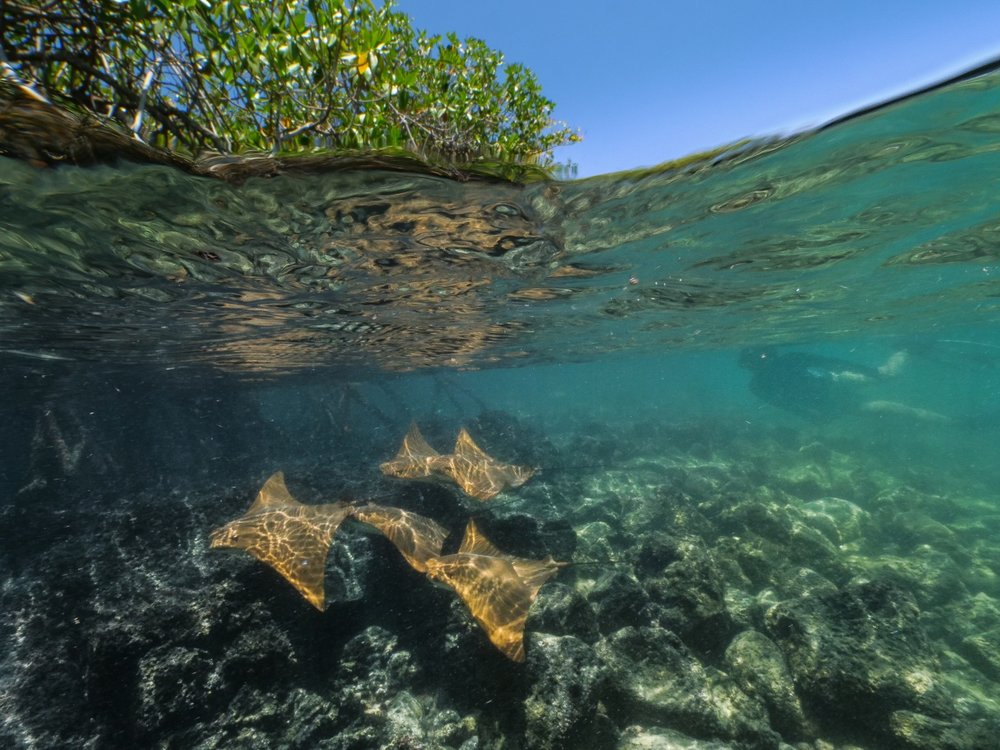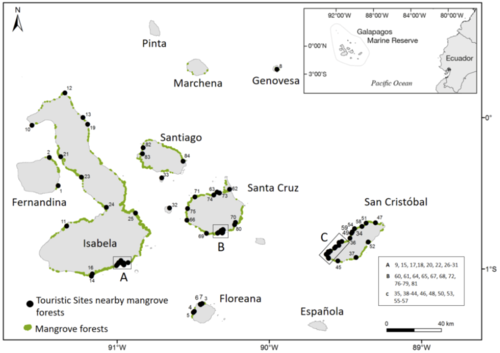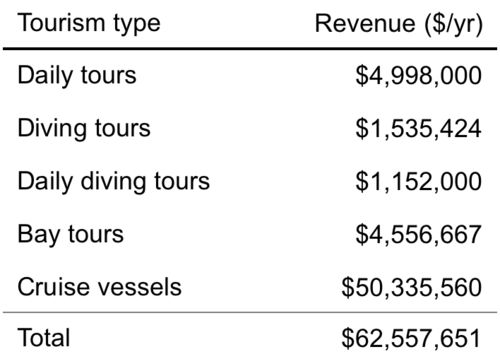Michael Tanner[1], Nicolás Moity[1], Matthew T. Costa[2], José Marín Jarrin[3], Octavio Aburto-Oropeza[2], Pelayo Salinas-de-León[1,4]
[1]Charles Darwin Research Station, Charles Darwin Foundation, [2]Scripps Institution of Oceanography, [3]Humboldt State University, [4]National Geographic Society

Figure 1. Mangroves in Galapagos. Photo: Nicolas Moity/ Charles Darwin Foundation
Mangroves are increasingly recognized as one of the most productive ecosystems on Earth, given the multitude of benefits, or ecosystem services, that they provide for coastal communities and mankind at large (McNally et al. 2011). For example, as much as 80% of global fish catches are directly or indirectly linked with mangrove ecosystems (Ellison 2008). Mangroves are also disproportionately important to global carbon storage, ranking on par with the most carbon-rich tropical forests in the world (Donato et al. 2011). And mangroves support local tourism industries, both by affording recreational opportunities (Thiagarajah et al. 2015) and by providing water purification and coastal protection, which are crucial to maintaining clear waters and sandy beaches (Lau 2013). In Belize, for example, investigators estimated mangroves’ contribution to tourism at over US$60 million per year (Waite et al. 2014).
Sadly, despite the known importance of mangrove forests, they have been subject to destructive human practices worldwide. In Ecuador alone, we have lost over 40% of mangrove coverage in the last 40 years, with only the Galapagos Islands maintaining their mangroves close to a pristine state (Hamilton and Lovette 2015). If current rates of deforestation continue, all mangroves in the world could be lost within the next century (Duke et al. 2007).
The loss of such a valuable ecosystem is partly explained by the fact that mangrove benefits, and in general most benefits provided by nature, are pure public goods, with no visible price tag. This favors destructive uses of mangroves that are easily monetized, such as shrimp farming.
To better reveal the true contribution of Galapagos mangroves to the Islands and their people, over the past three years the Charles Darwin Foundation, Galapagos National Park Directorate, Scripps Institution of Oceanography, and volunteers from the University of Wisconsin at Eau Claire have carried out a large-scale, interdisciplinary effort to estimate the monetary value of the ecosystem services provided by Galapagos mangroves. We evaluated three ecosystem services that we believe are most representative and policy-relevant for the Archipelago and its society. First, we calculated the value of carbon storage provided by mangroves, within the context of possible climate change policies. Next, we assessed the importance of mangroves in sustaining fisheries, through their function as a nursery and habitat for species of local commercial importance. Finally, we considered the vital role of mangroves in supporting tourism and recreation, which are the economic engine of Galapagos.
CARBON CAPTURE
To measure soil carbon stored in Galapagos mangroves, a team of scientists from Scripps Institution of Oceanography and the Charles Darwin Foundation took soil samples at 29 sites on all islands that host mangroves (Figure 2). This herculean task, carried out in April 2015, required visiting mangrove bays on six islands: Fernandina, Floreana, Isabela, San Cristobal, Santa Cruz and Santiago. The soil samples taken in the field were later analysed at labs in California to estimate carbon content.
We found that on average, the soil of Galapagos mangroves stores about 211 tons of carbon per hectare, which amounts to over 778,000 total tons of carbon – the equivalent of 15% of Ecuador’s annual carbon emissions in 2016! This figure is even more impressive when you consider that Galapagos mangroves represent less than 3% of the total mangrove coverage in all of Ecuador (Figure 3; Tanner et al. 2019).

Figure 2. Science in action: sampling of mangrove sediment cores for carbon measurements. Using a Russian peat corer, we took sediment cores at depth increments of 25 cm, then dried and weighed them for lab analysis. Photo: Octavio Aburto / Charles Darwin Foundation

Our team sought an appropriate way to value this amount of carbon, which would capture the utilitarian benefits of Galapagos mangroves’ carbon storage to the Islands, to Ecuador, and to human welfare in general. We decided to use two complementary valuation techniques. One is the market approach, which estimates the potential revenues associated with trading credits in carbon markets. For this, we used the average price of a carbon credit traded in Latin America in 2017, which was US$13.93 per ton of carbon. Our other valuation technique, called the social cost of carbon, was an estimate of the social damage avoided by not releasing carbon into the atmosphere. For this approach, we chose the social cost of carbon estimated in 2016 by the United States Environmental Protection Agency – US$132 per ton of carbon.
Using the market approach, we estimated that the carbon stored in Galapagos mangroves is worth over US$10.8 million, or $2,940 per hectare of mangrove. Alternatively, using the social cost of carbon technique, we calculated that carbon stored in Galapagos mangroves is worth over US$102 million, or $27,852 per hectare.
Given that Galapagos mangroves grow on volcanic rocks, with little sediment and no constant sources of fresh water, their capacity for carbon storage is quite surprising. Their carbon stocks are similar to or larger than those of temperate, boreal or cloud forests (Alongi 2012). The Scalesia forest in the Galapagos highlands holds 60 tons of carbon per hectare (Kitayama and Itow 1999) – less than a third of that found in Galapagos mangroves. When compared to other mangrove ecosystems, Galapagos is on the lower end of the carbon storage spectrum, which is probably explained by our mangroves’ small size and the harsh conditions they grow in.
MANGROVE DEPENDENT FISHERIES

Figure 4. Snappers swim between submerged mangrove roots in the Galapagos Archipelago. Photo: Enric Sala / National Geographic Pristine Seas
Recent studies have highlighted the importance of Galapagos mangroves in supporting local artisanal fisheries (Aguaiza 2016; Fierro 2017). We sought to understand exactly how important mangroves are to these fisheries in economic terms.
Our team first went snorkelling, conducting censuses of over 30 mangrove bays. During these censuses, we visually identified all species of high commercial importance for artisanal fishers in the Galapagos fin-fishery, which focuses on coastal and demersal species (Molina et al. 2004).
For each of these commercially important species, we estimated the total landings in Galapagos per year. We used market prices to calculate total revenues from these landings, and we subtracted the costs of fishing these specific species to arrive at the net economic benefits. Costs included fuel, wages, fishing gear, and vessel maintenance. We gleaned our data from a variety of sources, including the Galapagos National Park Directorate, peer-reviewed and grey literature, and interviews with fishermen.
Our results are important: The Galapagos fin-fishery receives over US$900,000 of net benefits each year from mangrove habitat (Table 1). In particular, snapper, mullets and the Galapagos grouper “bacalao”, which comprise the bulk of catches of this fishery (Schiller et al. 2015), are dependent on mangroves as habitat and nursery areas. Another important fishery in Galapagos, the lobster fishery, is likely also dependent on healthy mangrove ecosystems, though the links have not yet been proven.

Table 1. Value of mangroves for important species in Galapagos artisanal fisheries. Estimates of fishing costs are expressed as a percent of gross revenues and were obtained from interviews with fishermen. For more details, see Tanner et al. (2019).
MANGROVE-BASED TOURISM

Figure 5. Snorkelling with golden rays in Galapagos mangrove bays. Photo: Pelayo Salinas de León / Charles Darwin Foundation

Tourism represents the lion’s share of the Galapagos economy, providing about 80% of total employment in the Islands (Epler 2007). We set out to estimate the contribution of mangroves to the tourism industry. Cultural ecosystem services like tourism and recreation are widely cited as mangrove benefits, but thus far there have been few efforts to quantify the value of these services (Barbier and Hacker 2011; Salem and Mercer 2012).
With support from the Galapagos National Park’s Public Use Directorate and the Galapagos Tourism Observatory, we first identified 84 tourist sites that were within 500 meters of mangroves, which we considered mangrove-based tourism sites.
We then estimated the total number of tours to each of these sites per year. We assigned an annual monetary value to the tours according to the average price paid by each visitor, the average number of visitors per tour, and the average days that tours operated each year.

We found that 47% of all tourist sites in Galapagos are mangrove-based, and that the tourism sector receives over $62 million of revenue from visits to these each year (Table 2).
IMPLICATIONS AND POLICY RECOMMENDATIONS
Galapagos mangroves provide a multitude of high value benefits, which are important for policymaking at both the local and national level. For example, our carbon storage estimates clearly indicate that mangrove conservation is key to any national climate change mitigation strategy, especially in the face of international commitments such as the Paris Agreement. If Galapagos mangroves stock this amount of carbon, imagine the amounts in Esmeraldas, which contains the tallest mangroves in the world!
Mangroves also play a key role in maintaining long-term sustainability of fisheries, with important implications for Galapagos food security and the health of our artisanal fishing sector. Clearly, no-take areas in coastal habitats should be expanded to include mangroves. Management plans for mangrove-dependent fish species currently do not exist and are an urgent necessity if our goal is to secure our fisheries for future generations. These management plans should include measures such as fisheries closures during reproductive periods and restrictions on catch size.
The tourism industry is the biggest beneficiary of mangrove ecosystem services and could play a central role in safeguarding mangroves in the long term, perhaps through application of a Payment for Ecosystem Services scheme. For example, Galapagos could create a local carbon offsets market, where the tourism sector mitigates its carbon emissions through payments that finance mangrove conservation.
Galapagos is the only Ecuadorian province that hasn’t experienced mangrove deforestation, and it serves as a prime example of the benefits a pristine mangrove ecosystem can provide. Our study could be replicated in other regions of the country where mangroves are under threat.
This research did not intend to put a price on nature. Our aim was to use an interdisciplinary approach to reveal the true value of mangroves in the Galapagos Islands, thus presenting a compelling case for conservation based on both ethical and economic grounds.
ACKNOWLEDGEMENTS
This research was conducted under Galapagos National Park Directorate research permit PC-13-15, PC-13-16, PC-13-17 and PC-13-18 granted to the Charles Darwin Research Station. Special thanks to John Lynham and Juan Carlos Izurieta for suggestions made to this research. We are very grateful to Kayla Budd and Alex Sueldo from the University of Wisconsin at Eau Claire, who volunteered at the Charles Darwin Foundation specifically within this project. This work was supported by The Leona M. and Harry B. Helmsley Charitable Trust and is contribution number 2233 from the Charles Darwin Research Station.
REFERENCES
Aguaiza C. 2016. The role of mangroves as nursery habitats for coral reef fish species in the Galapagos Islands. M.Sc. thesis. University of Queensland, Brisbane, Australia.
Alongi DM. 2012. Carbon sequestration in mangrove forests. Carbon Manag. 3: 313–322. https://doi.org/10.4155/cmt.12.20
Barbier E & SD Hacker. 2011. The value of estuarine and coastal ecosystem services. Ecol. Monogr. 81: 169–193.
Donato DC, Kauffman JB, Murdiyarso D, Kurnianto S, Stidham M & M Kanninen. 2011. Mangroves among the most carbon-rich forests in the tropics. Nat. Geosci. 4: 293–297. https://doi.org/10.1038/ngeo1123
Duke NC, Meynecke JO, Dittmann S, Ellison AM, Anger K, Berger U, Canicci S, Diele K, Ewel KC, Field CD, Koedam N, Lee SY, Marchand C, Nordhaus I, & F Dahdouh-Guebas. 2007. A World Without Mangroves? Science 317 (5834): 41–43. https://doi.org/10.1126/science.317.5834.41b
Ellison AM. 2008. Managing mangroves with benthic biodiversity in mind: Moving beyond roving banditry. J. Sea Res. 59: 2–15. https://doi.org/10.1016/j.seares.2007.05.003
Epler B. 2007. Tourism, the Economy, Population Growth, and Conservation in Galapagos 55.
Fierro D. 2017. Fish assemblages in mangrove habitats of the Galapagos Archipelago: A comparison of survey techniques and assemblage composition between bioregions. M.Sc. thesis, University of Western Australia, Perth, Australia.
Hamilton SE & J Lovette. 2015. Ecuador’s mangrove forest carbon stocks: A spatiotemporal analysis of living carbon holdings and their depletion since the advent of commercial aquaculture. PLoS One 10: 1–14. https://doi.org/10.1371/journal.pone.0118880
Kitayama K & S Itow. 1999. Aboveground biomass and soil nutrient pools of a Scalesia pedunculata montane forest on Santa Cruz, Galápagos, Ecological Research 14(4): 405–408.
Lau WWY. 2013. Beyond carbon: Conceptualizing payments for ecosystem services in blue forests on carbon and other marine and coastal ecosystem services. Ocean Coast. Manag. 83: 5–14. https://doi.org/10.1016/j.ocecoaman.2012.03.011
McNally CG, Uchida E & AJ Gold. 2011. The effect of a protected area on the tradeoffs between short-run and long-run benefits from mangrove ecosystems. Proc. Natl. Acad. Sci. USA. 108: 13945–13950. https://doi.org/10.1073/pnas.1101825108
Molina L, Danulat E, Oviedo M & JA González. 2004. Guía de especies de interés pesquero en la Reserva marina de Galápagos. Puerto Ayora.
Salem ME & DE Mercer. 2012. The economic value of mangroves: A meta-analysis. Sustainability 4: 359–383. https://doi.org/10.3390/su4030359
Schiller L, Alava JJ, Grove J, Reck G & D Pauly. 2015. The demise of Darwin’s fishes: Evidence of fishing down and illegal shark finning in the Galapagos Islands. Aquat. Conserv. Mar. Freshw. Ecosyst. 25: 431–446. https://doi.org/10.1002/aqc.2458
Tanner MK, Moity N, Costa MT, Jarrin JM, Aburto-Oropeza O & P Salinas-de-León. 2019. Mangroves in the Galapagos: Ecosystem services and their valuation. Ecol. Econ. 160: 12-24. https://doi.org/10.1016/j.ecolecon.2019.01.024.
Thiagarajah J, Wong SKM, Richards DR & DA Friess. 2015. Historical and contemporary cultural ecosystem service values in the rapidly urbanizing city state of Singapore. Ambio 44: 666–677. https://doi.org/10.1007/s13280-015-0647-7
Waite R, Burke L, Gray E, van Beukering P, Brander L, McKenzie E, Pendleton L, Schuhmann P & E Tompkins. 2014. Coastal Capital: Ecosystem Valuation for Decision Making in the Caribbean. World Resources Institute.
